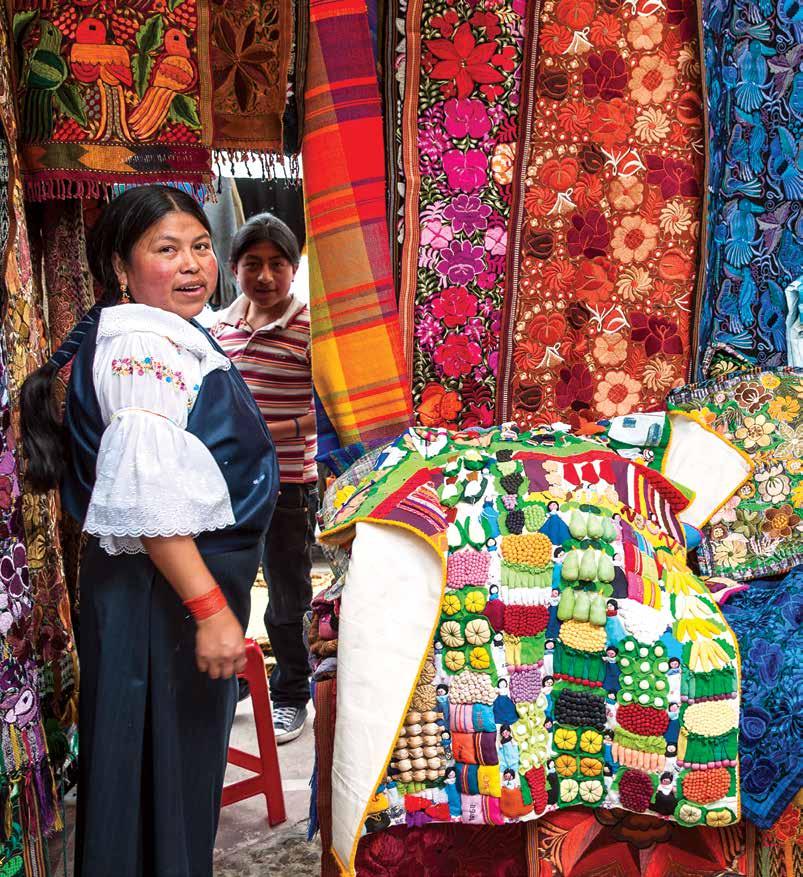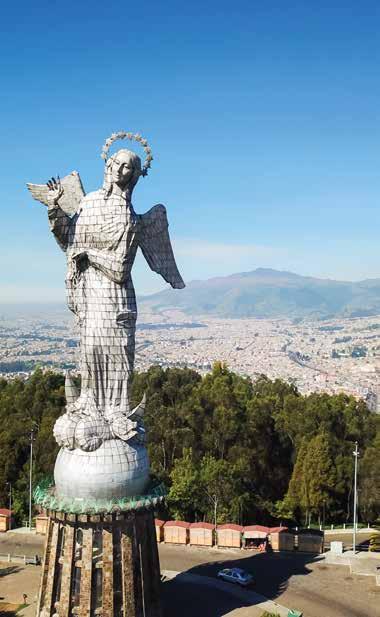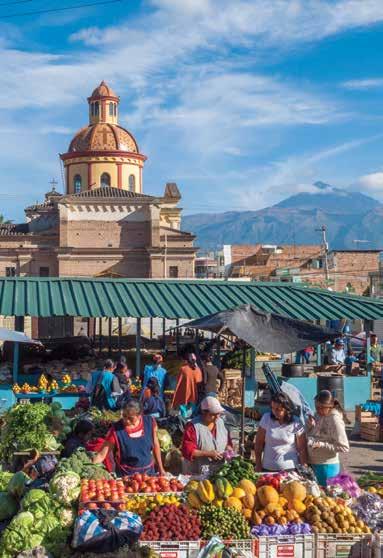
6 minute read
Captivating Quito
from Bon Vivant Fall 2019
by Ensemble
Captivating QUITO
This gateway to Ecuador is a enthralling place to delight all your sense, especially that of taste
BY JILL GLEESON
I’M EMBARRASSED TO ADMIT MY recent, abbreviated stay in Quito was an afterthought, really; a few days I tacked on to the front of a Galapagos trip with no more consideration or anticipation than the half-formed notion, “since I have to fly into there anyway…”
Filled with visions of massive, stately tortoises and comical blue-footed boobies, my brain had little room for mainland Ecuador, as spectacular as it might be. But while memories of the animals I saw on the islands Charles Darwin made legend will remain cherished, so will the sights and sounds – and the tastes, too – of the Ecuadorian capital.

Textile market, Quito, Ecuador
Before I arrived, I only had the barest of plans for my time in the city – just a room at Casa Joaquin Boutique Hotel, which is tucked away within a beautifully restored colonial house in La Mariscal. The district is home to a bustling nightlife scene, but I was more interested in the tours the innkeeper could arrange for me.
I decided to spend my first full day in the country exploring Quito, which I discovered was not only UNESCO’s first World Heritage Site city but also features the biggest, best-preserved historical centre in Latin America.
I was happy to find the next morning that Casa Joaquin serves a nice selection of dishes for its complimentary breakfast, but I only had eyes for the fruit, artfully arranged on platters. Fruit consumed in the tropics is so sweet and juicy and flavourful, it bears almost no resemblance to what we eat in Canada or the U.S. And all of my favourites were there: mango and papaya, starfruit and passion fruit.

Virgen de El Panecillo
There were also several I was unfamiliar with, including granadilla. A member of the passion fruit family, it’s about the size of a tennis ball with a hard, shiny orange-colored rind. The flesh is strangely gelatinous and filled with black seeds, but its sweet, subtle taste is far more enjoyable than its texture. Apparently it’s good for digestion, as well.
That was excellent news because I was slightly queasy, no doubt a result of Quito’s soaring elevation. Located in the Andes mountains nearly 2,900 metres above sea level, it’s the world’s second-highest capital. It’s also built on the ruins of an ancient Inca city, my guide Pablo told me, with a historic centre that dates back half a millennium to the time of the Spanish conquistadors.
I’d be having a late lunch in Old Town, but first we headed off to the Virgen de El Panecillo. The massive aluminium mosaic statue of a winged Virgin Mary, which was dedicated in 1976, rises 200 metres above Quito on a bread loaf-shaped hilltop.

Quito’s 18th-century buildings
“That’s the tallest aluminium statue in the world,” Pablo told me, as I stood staring up at it, dumbstruck. “It’s 41 metres high, even taller than Christ the Redeemer in Brazil. The Inca worshipped the sun on this hill – they called it Hill of the Heart, or ‘Shungoloma.’ But now the Virgin is here, watching over the city and its people.”
The Virgin, who is depicted standing atop a serpent, manages to look fierce as well as beatific, but even more impressive was the 360-degree view from the hilltop. The entire city unspooled beneath me, the mountains soaring in the distance.
I was glad we’d stopped here first – Pablo told me it’s usual for clouds to shroud the Andes by afternoon. He asked me if I wanted to visit the small museum in the base of the monument but I was ready to wander Quito’s colonial quarter, knowing it would end in a traditional Ecuadorian meal.
The granadilla had done its trick; my stomach had settled down, though the city’s sky-high elevation had me panting like a puppy on a hot summer day when I climbed more than a few stairs.

Fanesca soup
We parked the car and began with a stroll through the curving, pedestrian-only La Ronda, a long-time magnet for the city’s bohemians. The cobblestone street’s brightly hued, 18th-century buildings have been restored to their former glory, and contain a festive assortment of galleries, craft shops, restaurants and bars, including La Heladeria Dulce Placer.
It dishes up literally hundreds of varieties of ice cream, including the surprisingly good humita flavour, which tastes like a sweet corn cake.
I could have lingered on La Ronda for hours, but Pablo ushered me on toward Plaza de la Independencia, Quito’s biggest and oldest public square. It began to dawn on me, Galapagos still to come or not, I should have booked more time – a week, perhaps? – in this unexpectedly seductive city.
As we strolled toward Independence Square, Pablo pointed out Hotel Plaza Grande. A five-star colonial showstopper, it serves some of Ecuador’s finest dinners in La Belle Epoque, a French restaurant also known for its live opera performances.

Produce market in Otavalo
I noted the recommendation for my next visit before my attention was stolen by the magnificent plaza before me. Bordered by the Cathedral of Quito and the Presidential, Municipal and Archbishop’s palaces, with an impressive central monument celebrating Ecuador’s independence from Spain, it was even more notable for the fascinating mix of humans within.
Students, shoe shiners, businessmen, buskers and other locals selling everything from peacock feathers to boiled eggs all loitered peaceably together under the palm trees. I had a moment to grin at the glorious spectacle before following Pablo into the Centro Cultural Metropolitano.
Located just off the plaza on what is said to have been the site of a palace belonging to Inca ruler Atahualpa, the restored building that houses the centre was once, variously, Jesuit headquarters, a prison, a tobacco factory and a mint.

Tropical drink served with granadilla
Today, it provides space for the municipal library, exhibits from Ecuadorian and international artists and, most crucially to my now-growling stomach, a café.
I asked Pablo what the best Ecuadorian dish was on the menu, and without hesitation he replied, “Fanesca." "It's a stew, or thick soup, really served only at Lent, so you’re lucky that you get to try it," he explained. "They do a really good version here. Of course, just about everyone makes it a little bit different...I used to love to watch my mom and aunts make it. I still do, whenever I go home at Easter. It takes days to do it right.”
According to Pablo, there are 12 different legumes or grains in the soup, which represent the 12 apostles, although it’s supposed the dish pre-dates the arrival of Christianity in the region and might have been prepared during harvest as a way of giving thanks to Pachamama, or Mother Earth. Typically, it includes salt cod and a milk base, as well as peas, beans of several sorts, lentils and corn, all of which are peeled separately.
Mine came laden with hard boiled eggs, empanadas and parsley – favourite fanesca garnishes. There were peanuts in it, and I thought I detected a very slight pumpkin taste, as well as the flavour of fried onions and garlic, though there wasn’t a single seasoning that overwhelmed the others.

Cathedral of Quito
While Pablo told me that some fanesca is served spicy, this version was mild and incredibly creamy. It was filling – I was soon dreaming of a siesta – but so good I finished the entire portion. When I think of all the activities I managed to undertake during my short time in Quito, there was none that gave me a better peek at the Ecuadorian culture than eating fanesca as Pablo fondly described how his family prepares it.
When I dream of going back to the country, it’s always at Easter, when I’m certain I’ll be able to sample fanesca again.








